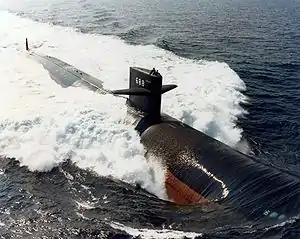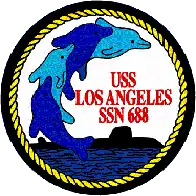 | |
| History | |
|---|---|
| Name | USS Los Angeles |
| Namesake | City of Los Angeles |
| Awarded | 8 January 1971[1] |
| Builder | Newport News Shipbuilding |
| Laid down | 8 January 1972[1] |
| Launched | 6 April 1974[1] |
| Commissioned | 13 November 1976[1] |
| Decommissioned | 4 February 2011[1] |
| Out of service | 1 February 2010[1] |
| Stricken | 4 February 2011[1] |
| Homeport | Pearl Harbor |
| Fate | Disposed of by Recycling[1] |
| Badge |  |
| General characteristics | |
| Class and type | Los Angeles-class submarine |
| Displacement |
|
| Length | 110.3 m (361 ft 11 in) |
| Beam | 10 m (32 ft 10 in) |
| Draft | 9.4 m (30 ft 10 in) |
| Propulsion |
|
| Speed |
|
| Test depth | 290 m (950 ft) |
| Complement | 13 Officers; 121 Enlisted |
| Armament |
|
USS Los Angeles (SSN-688), lead ship of her class of submarines, was the fourth ship of the United States Navy to be named for Los Angeles, California. The contract to build her was awarded to Newport News Shipbuilding and Dry Dock Company in Newport News, Virginia on 8 January 1971 and her keel was laid down on 8 January 1972. She was launched on 6 April 1974 sponsored by Anne Armstrong, and commissioned on 13 November 1976. She hosted President Jimmy Carter and the First Lady on 27 May 1977 for an at-sea demonstration of her capabilities.[2] In 2007 she was the oldest submarine in active service with the United States Navy.[3] The Navy decommissioned Los Angeles on 23 January 2010, in the Port of Los Angeles, Los Angeles, California, her namesake city.[4]
Deployments

Los Angeles made her first operational deployment to the Mediterranean Sea in 1977 and was awarded a Meritorious Unit Citation. In 1978, she transferred to the Pacific Fleet and was assigned to Submarine Squadron 7, homeported in Pearl Harbor. She conducted 17 Pacific deployments over the next 32 years and earned eight Meritorious Unit Citations and a Navy Unit Citation. Los Angeles participated in four multinational "Rim of the Pacific" (RIMPAC) exercises, and visited numerous foreign ports in Italy, Republic of the Philippines, Diego Garcia, Hong Kong, Mauritius, Australia, Japan, Republic of Korea, Canada and Singapore.[2]
In 1999, Los Angeles was modified to carry a Dry Deck Shelter (DDS). Her capabilities included undersea warfare, surface warfare, strike warfare, mining operations, special forces delivery, reconnaissance, carrier battle group support and escort, and intelligence collection.[5]
Decommissioning
Los Angeles was inactivated on 1 February 2010 and decommissioned 4 February 2011. The wardroom of the oldest submarine in the fleet carries Richard O'Kane's personal cribbage board, and upon her decommissioning the board was transferred to the next oldest boat at that time, USS Bremerton (SSN-698).[6][7] Ex-Los Angeles entered the Navy's Ship-Submarine Recycling Program, 1 February 2010,[8] and recycling was completed 30 November 2012.[1]
References
- 1 2 3 4 5 6 7 8 9 "Los Angeles (SSN 688)". Naval Vessel Register. United States Navy. 4 January 2012. Retrieved 2 February 2012.
- 1 2 Ronald Gutridge (15 January 2010). "Pearl Harbor Bids Farewell to USS Los Angeles". US Navy. Archived from the original on 6 June 2011.
- ↑ "USS Los Angeles Embarks With a Piece of Submarine History". US Navy. 16 May 2007.
- ↑ Tony Perry (24 January 2010). "Submarine Los Angeles is decommissioned from active fleet". Los Angeles Times.
- ↑ Zingaro, Michael B (8 November 2019), The O'Kane Cribbage Board Is Passed Down, DVIDS
- ↑ "USS Los Angeles Embarks With a Piece of Submarine History". US Navy. 16 May 2007.
- ↑ Morison, Samuel L. "US Naval Battle Force Changes 1 January 2011 to 31 December 2010" (PDF). Proceedings. US Naval Institute (May 2011).
- This article includes information collected from the Naval Vessel Register, which, as a U.S. government publication, is in the public domain. The entry can be found here.